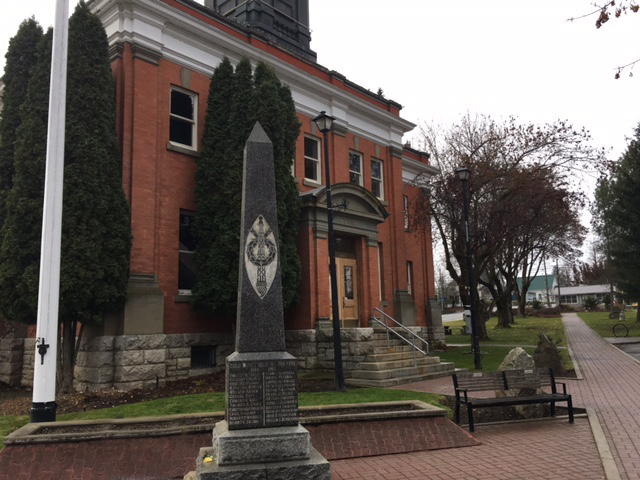City could have avoided property tax increase: Tripp
A “missed” budget meeting on prioritizing and trimming the list of planned capital projects might have saved the city hiking property taxes this year, says one city councilor.
Beverley Tripp said she missed the last meeting when city council decided to move ahead with the option to increase property taxes in Grand Forks by 3.5 per cent — she was having eye surgery — and would have voted against the current budget.
Although Tripp admitted the time had really passed to make amendments on Monday when council approved the first three readings on the five-year financial plan — including a 3.5 per cent increase for property taxes and a 4.8 per cent increase in property values from B.C. Assessment — she was disappointed in council’s decision.
“I think this council could have done better,” said Tripp.
She claimed council was told by its chief administrative officer at the time, Doug Allin, that there would be a final meeting to go over the capital projects budget and see where the city could have saved, eliminated or reduced money but it did not happen.
“I do believe that it would have been good for us as a council to have sat down, gone through capital projects, looked at how staff have rated those,” she said.
“There were a number of projects that were ($20,000) and under, and I think we could have collectively come to a shaving off of funds from some of those and then we wouldn’t have had to go with option three for the tax increase.”
Coun. Colleen Ross admitted there was some concern over capital projects but there had been plenty of opportunity throughout the budget process to raise that concern and get projects trimmed, but no one came forward with the motion.
“But I feel really prepared to support this budget,” she said, despite voting against the increase earlier in the month when the budget options — including no increase — were discussed.
Council approved the increase of 3.5 per cent — $125,062 — towards infrastructure renewal and replacement over and above the additional revenues resulting from assessment increases, for total property tax revenues of $3,698,273. The financial plan now awaits adoption at the city’s next regular meeting.
But because of the increased assessments the city has had from B.C. Assessment a lot of the property values have gone up in the city, and the actual increase the city is realizing already in taxes is 4.08 per cent, meaning a total taxation increase of $163,000.
Review and analysis of the 2017 completed assessment roll indicates that the assessed value of residential properties in Grand Forks has increased an average of 4.08 per cent due to market changes, plus a further approximately three per cent overall as a result of the desktop review process recently conducted by B.C. Assessment, read a city staff report to council.
City chief administrative officer at the time, Doug Allin, said the Asset Management Financial Plan Bylaw recommended that the city reach 50 per cent of its asset replacement, but the city was currently only at 44 per cent.
“The windfall we will realize as a result of property taxes and the B.C. Assessment rate going up will allow us meet that objective,” he said. “If you hold the line now you won’t reach your objective and you are so close to the 20-year plan.”
The cost impacts on a residence with a 2016 assessed value of $200,000 — and with an assessment increase of 3.5 per cent — with the city’s increase are $79.61, bumping the property tax payment over $1,000 to $1,041.09.
Sections 165 and 166 of the Community Charter require a municipality to adopt a five-year financial plan annually, before the annual property tax bylaw is adopted, and to include public consultation as part of the process prior to adoption of the financial plan.
After conducting five public workshops during January and February, city staff was instructed to present council with three options for tax revenue increases to incorporate into the financial plan.
These options were presented at the committee-of-the-whole meeting on March 13 during introduction of the bylaw, in order to select one for three readings of the bylaw.
There was one minor change which had been made to the operating budget since its introduction on March 13. An additional expense of $7,671 has been included for the city’s contribution to the Regional District of Kootenay Boundary to fund a transit shortfall.
City revenue sources for the coming budget were cited as coming from six areas, with the largest being fees and charges (34.6 per cent) comprising $7,512,874 of the total of $21,738,663.
Other sources (25 per cent, $5,435,392) were second while property value taxes were third at 17.6 per cent ($3,816,587).
Reserve funding (15.6 per cent, $3,383,800), proceeds from borrowing (6.6 per cent, $1,428,784) and parcel taxes (0.7 per cent, $161,226) rounded out the list.
The 2017 distribution of property tax rates among the different classes has not yet been determined. Based on rate multiples consistent with prior years, residential pays the majority of property taxes in Grand Forks at 54.20 per cent, while major industry is next at 22.07 per cent.
Business shells out 20.95 per cent, light industry 1.43 per cent and utilities 1.32 per cent. Recreation/non profit and farm made up less than one per cent of property value taxes.






















